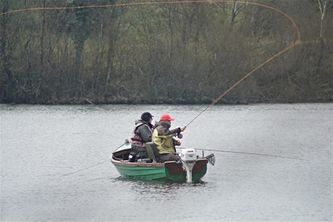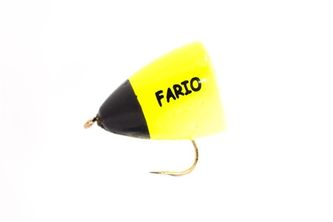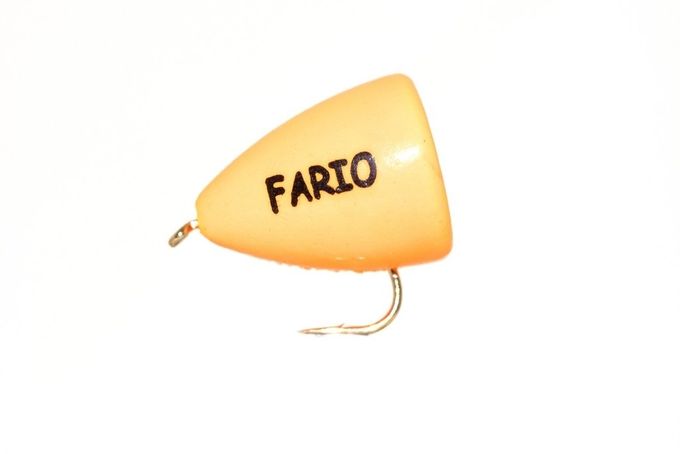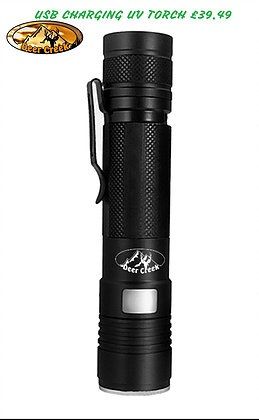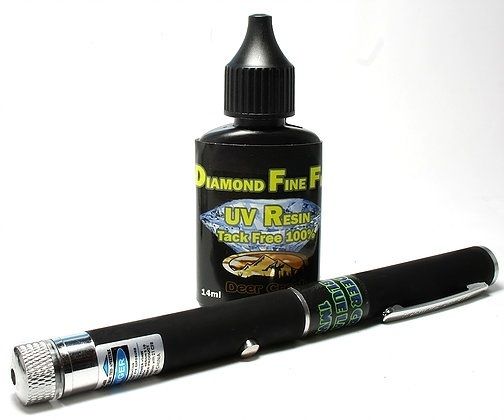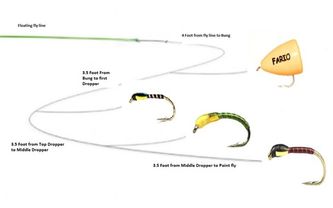THE BUNG AND BUZZERS
Spring brings the first hatch of fly to many of our lakes and with the first hatches of fly the fishing can be very good indeed.
These flies are buzzers and can range anywhere in hook sizes from size 18 up to size 10. The buzzers are mainly black but you can often find a few olive ones in the mix.
The weather really dictates how you can fish for trout feeding on buzzers.
If it’s windy, a nice ripple or even a flat calm, your need to approach the fishing slightly differently for each condition.
Direction of the wind and temperature of the water as I have said before are the main factors that will help or hinder a fly hatch, but even on the windiest coldest days you can still find some fly hatching on the lee shores. The water temperature will often have a huge effect on the buzzers movement, if the water is very cold the buzzers will hardly move, but if the weather is mild the buzzers are much more active. This is the time to be out on the water, even if conditions are right only briefly, you can still have a good days sport.
Three Methods
Ok so, what methods will we employ to catch the trout? Well conditions, wind and temperature and cloud cover will tell you this.
If it’s cloudy warm and a nice ripple the fish will be taking the buzzer in the top 5 feet of water as the buzzers will be high in the water layers getting ready to hatch and it is at this vulnerable stage just before and as the buzzer hatches the fish feast on them. During these conditions you can use a floating or midge tip line and a team of buzzers , up to 4 fly’s may be employed on a 12 to 20ft Leader depending on the depth of water. This is called straight lining, you cast the team of flies out, one strip to straighten your line and leader and then just keep in touch with the buzzers as the boat drifts towards them with a slow figure of eight retrieve, trying to keep in touch without moving your fly’s is a skill and can be perfected over time.
The second method is the washing line, this again can be employed using the same 12 to 20 ft long leader with 2 or 3 buzzers on the droppers and a buoyant fly such as a booby on the point. The size of booby eyes will also help you fish the buzzers where you want to fish them in the water column. The bigger the booby eyes the higher you can fish the team of flies, the smaller the eyes on the booby the deeper the flies will sink. Why use a booby, well to be truthful I use it mainly to slow the descent of my buzzers in the water column, but I also use it to catch fish. On hard days with little fly activity you can get a few pulls using the booby as an attractor, Fab’s and blobs can also be employed on the point when using this method. But each of these point flies sink differently and will hold your flies higher in the water column in the case of a big 9mm eyed booby or by using a small eyed booby, fab or blob will help the team of flies descend slower.
The third method, THE BUNG is the method that I want to explain in more detail. The bung is a highly controversial method in our sport, I really don’t understand the reasoning behind this, as it’s everyone’s aim when out fishing to catch fish.
Especially competition anglers. Our sport is not called sailing, hiking or camping, the sport we all love is called fishing.
Some say it’s catching fish at all costs when employing this method- I don’t agree with this at all and I am truly very passionate about this.
I am a competition angler and my goal is to win competitions and I will employ any method that will give me the best returns in the allotted time on a competition day as long as it is a legal method, plus I really enjoy watching the indicator dip.
The Bung
To me the Bung helps me to put my flies in the exact area of the water column I want to fish them. Using the bung helps me holds the buzzers stationary at the depth determined by my leader length. It is exactly how coarse anglers fish using the long pole or waggler. It is accurate fishing, using the first two methods you sort of know what depth your flies are fishing at. With the Bung you know 100 percent what depth you are fishing your flies.
The bung was probably used first in New Zealand – a piece of yarn tied onto your leader a set distance up the cast with your nymph on the point.
Then this developed into the Klink and dink- a small Klinkhammer tied onto your leader with another piece of nylon 12-36 inches tied onto the bend of the hook of your Klinkhammer and a nymph again tied onto the end of this piece of tippet.
These methods have worked for many years and it’s did not take long for the reservoir anglers in the UK to cop onto how precise this fishing can be in presenting nymphs. The infamous bung was born and is now used on reservoirs, small Stillwater’s and rivers all over the world.
This bung can be made from anything really but the most common are hard pieces of brightly coloured, highly buoyant foam with or without a hook in it, its tied either inline or on a dropper, with nymphs, buzzers, lures, eggs, really any fly you could imagine suspended beneath the bung.
There is a huge array of bungs on the market, inline ones or ones on hooks in various sizes, shapes and colours. The question is which ones to use, when and how. Over the years I have used many different types of indicators whilst fly fishing, From the early days using huge amounts of CDC on the hook to suspend the weighted nymphs on the River Liffey when this technique was very uncommon, On Lough Corrib again using my CDC indicators whilst buzzer fishing and of course my home made foam and ball indicators I have used on the small Stillwater’s I frequent during the winter months.
But these indicators all have issues- CDC gets waterlogged and sink, the foam ones spin on your droppers as does the ball indicators with hooks in them. The large inline foam ball I used become damaged overtime and slid up and down your line even with plastic float stops attached either side of them. So I was always looking for the perfect indicator
Last year at the start of the winter puddle fishing I came across a New Bung from Fario. This Bung is durable and has a hook embedded into it, it also comes in a range of colours to suit light conditions, a problem I had in the past when fishing at distance on a cold sunny winters morning it was next to impossible to see the bung.
It rarely twists due to its shape and therefore does not damage your leader. Having a hook in it makes it competition legal too and I have found no problem with them so far.
Fishing the Bung
So how do you fish the bung, well on the reservoir and lakes during Buzzer time I usually use a floating line and a 10 to 18 foot leader of 6-8lb fluorocarbon, the bung is attached 4 ft. from the floating line to a dropper of 4 inches, the length of leader between the Bung and point fly can vary a lot, there are a number of factors to take into consideration, firstly the depth of water, length of rod you are using and most importantly the depth the fish are feeding at. If the fish are deeper than 14ft the Bung becomes useless as you cannot reach the fish. You will have to employ other methods to reach them.
I use a 10 ft. rod and the distance between the bung and the point fly should not exceed 14ft and I would only go to that depth if I had a long landing net, otherwise you will not be able to control the fish properly so you can land it. At 14ft this is the total extreme of length of cast I use under a bung, 8-10ft of leader is the norm and at times I would use as little as a 3ft of a leader under the bung with one fly. On a 10ft cast from bung to point fly I would use three buzzers under the bung spaced at equal distances.
I will always use a heavy fly on the point, i.e. your largest buzzer. Normally I put two size 12s on the first two droppers and a size 10 on the point. This helps the fly’s get down quickly to the depth you want them at. I use this team of flies early in the day when the buzzers are still deep but I will change the size shape and weight of buzzers on the cast during the day as the buzzers move higher in the water. Changing the weight of your buzzers helps your fly’s descend slower more naturally in the water and this can often catch you an extra fish or two.
Changing the weight of your buzzers is very important when fishing this method, I do not change the pattern of hook or style of fly, as the length of buzzer you are trying to imitate does not change in the middle of a hatch. If the natural buzzers are a size 10 they are a 10, if they are a 14 they are a 14, so I don’t see the point in changing hook sizes. Unless there are several kinds of buzzers hatching at once and that’s a totally different ball game. The hooks I use are kamasan B175 and Kamasan B110. I have never straightened theses hooks out whilst playing fish and therefore these hooks are my go to pattern of hook.
Resin and Flies
I mentioned changing the weight of your buzzer, how do I change their weight? Well when I am tying buzzers I tie them three different ways. The first set will get one coat of Deer Creek fine flex resin, the second set two coats and the third set I will give them up to four coats. When I say coat the flies, I just put enough resin on the fly so that the buzzer looks wet and then I remove all excess resin, I will then cure each coat with the uv torch and repeat the process as necessary. You will be surprised with the difference in sink rate of the flies are when u add extra coats. If you have never used resin before I would recommend Deer Creek Resin, it’s worked well for me for many years. Also if you do not tie flies then buy, I would highly recommend Fario flies as they have a nice range of buzzers and other competition and non-competition flies.
Try it and see
The bung can be fished in all conditions, from rolling 3 ft. waves to a flat calm, I have caught well on the bung in all conditions, I even managed one in the final hour on Lough mask in the Home international in Cushlough Bay this year on a size 16 buzzer in 4 ft. of water on a terrible blustery day to get me out of jail.
The last piece I would advise when fishing the bung from the boat would be to cast no more than 15 yards or as far from the boat as long as you can see your bung and any little dips or movement on the bung. I will strike at any movement of the bung as even the most subtle of movements will tell you a fish has taken your fly. After casting out the bung, straighten you cast with one or two pulls so that you are in direct contact with your team of flies. Let the fly’s sink and settle reaching their required depth. A slow figure of eight to stay in contact with the bung, but try not to move the bung. After about 30 seconds, give two long sharp pulls, this will pull your flies up in the water and then fall naturally once you stop retrieving. Doing this will sometimes induce the take. The Bung will also pop across the surface of the water creating lots of disturbance and will attract fish to the area, every now and again a fish may even take the bung.
Enjoy your fishing
The second hatch of Large Buzzers should be hatching on most lakes, or will start soon and the sport can be hectic at times as the fish really like these large Buzzers. The above is how I fish buzzers , I am sure there are many other ways to fish buzzers , but by employing the techniques I mentioned above, I hope it will put an extra fish or two in the net for you, Tight lines !
Comments
Ronnie Chism
02.05.2021 20:42
Hi Dennis loved the article straight to the point .just wondered will the trout feed on the small buzzers all year ?
john carrigan
Just discovered this site, its great
denis
23.06.2020 16:01
01.03.2021 03:03
glad u enjoy, ty, will be back when the fishing returns
William Scully
19.03.2020 02:26
Great information Denis. To steal a phrase
“ now the biting makes sense”
denis
21.03.2020 22:11
thank you william
Allan
11.03.2020 18:06
Informative reading thanks
denis
ty
denis
21.03.2020 22:12
21.03.2020 22:11
ty
Shane
10.03.2020 17:52
Very informative and will be trying your techniques
David Martin
04.02.2020 11:49
Great info thanks
Tom Hipwell
13.05.2019 09:47
Great blogs and great info - thanks Denis
Phil Donoghue
26.04.2019 06:11
Very informative , keep it going Denis.
Phil berns
23.04.2019 21:36
Very good read there! Thanks Denis
Latest comments
19.05 | 05:47
Hi Denis
Good meeting last night, and enjoyed reading your blog. Felt I was on the lake with you. Great work
02.05 | 20:42
Hi Dennis loved the article straight to the point .just wondered will the trout feed on the small buzzers all year ?
06.04 | 11:57
Cant wait to read this
01.03 | 03:03
glad u enjoy, ty, will be back when the fishing returns
Share this page

